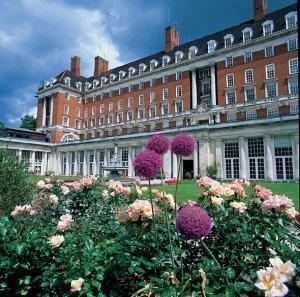Designated 30 May 1990 Opened 1924 | Completed 1924 Reference no. 1254353 Construction started 1921 | |
 | ||
Official name Royal Star and Garter Home Architects Edwin Cooper, Giles Gilbert Scott Similar Wick House - Richmon, West Hall - Kew, The Boathouse - Twickenham, 123 Mortlake High Street, Sudbrook Park - Petersham | ||
The Royal Star and Garter Home on Richmond Hill, in Richmond, London, was built between 1921 and 1924 to a design by Sir Edwin Cooper, based on a plan produced by Sir Giles Gilbert Scott in 1915, to provide accommodation and nursing facilities for 180 seriously injured servicemen.
Contents
Map of Royal Star %26 Garter Home, Richmond TW10 6RR, UK
The Royal Star & Garter Homes, the charitable trust running the home, announced in 2011 that it would be selling the building as it did not now meet modern requirements and could not be easily or economically upgraded. The building, which is Grade II listed, was sold in April 2013 for £50 million to a housing developer, London Square, which is restoring and converting the building into apartments.
The trust opened a new 60-room home in Solihull in the West Midlands in 2008 and the remaining residents at the Richmond home moved in August 2013 to a new purpose-built 63-room building in Upper Brighton Road, Surbiton, in the Royal Borough of Kingston upon Thames. A third home will open in High Wycombe, Buckinghamshire, in 2017. The possibility of opening a fourth home is also under consideration, and funds have been set aside for this purpose.
History
The site is the former location of the Star and Garter Hotel, which closed in 1906. The building was used as a military hospital, known as the Star and Garter Home for Disabled Sailors and Soldiers, during World War I.
The site was then donated to Queen Mary (consort of George V) in support of her plans to establish a home for paralysed and permanently disabled soldiers. The hotel banqueting hall and ballroom were temporarily used to house disabled soldiers, but they were found to be unsuitable for their specialised needs. Demolition of the hotel buildings commenced in 1919 and from 1920 to 1924 the home's residents were transferred to Sandgate, Kent while the new Star and Garter Home for Disabled Sailors, Soldiers and Airmen was built on the site of the hotel. The new building was dedicated in 1924 as the Women of the Empire's Memorial of the Great War. It was formally opened by George V and Queen Mary on 10 July 1924.
In 1948 residents of the home took part in a forerunner of the Paralympic Games, the first national athletic event for disabled athletes, organised by Dr Ludwig Guttmann.
The Star and Garter Home received its royal charter in 1979, adding the prefix "Royal" to its name. Since the opening of the second home at Solihull in 2008 the charity has used a plural form of the name, as "The Royal Star & Garter Homes".
Some of the residents who died at the home were buried in one of two dedicated sections in the nearby Richmond Cemetery. The cemetery contains two plots dedicated to deceased residents from the home, one of which is marked by the Bromhead Memorial, a large classical-style monument listing the names of those not commemorated elsewhere.
Notable residents
Notable residents have included:
